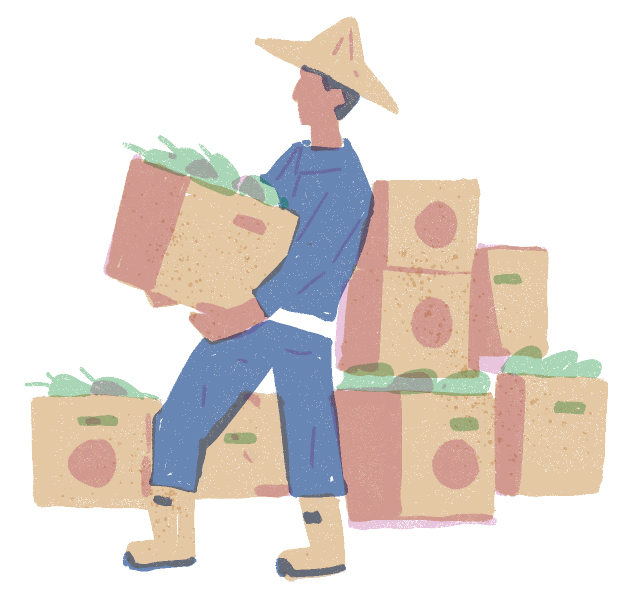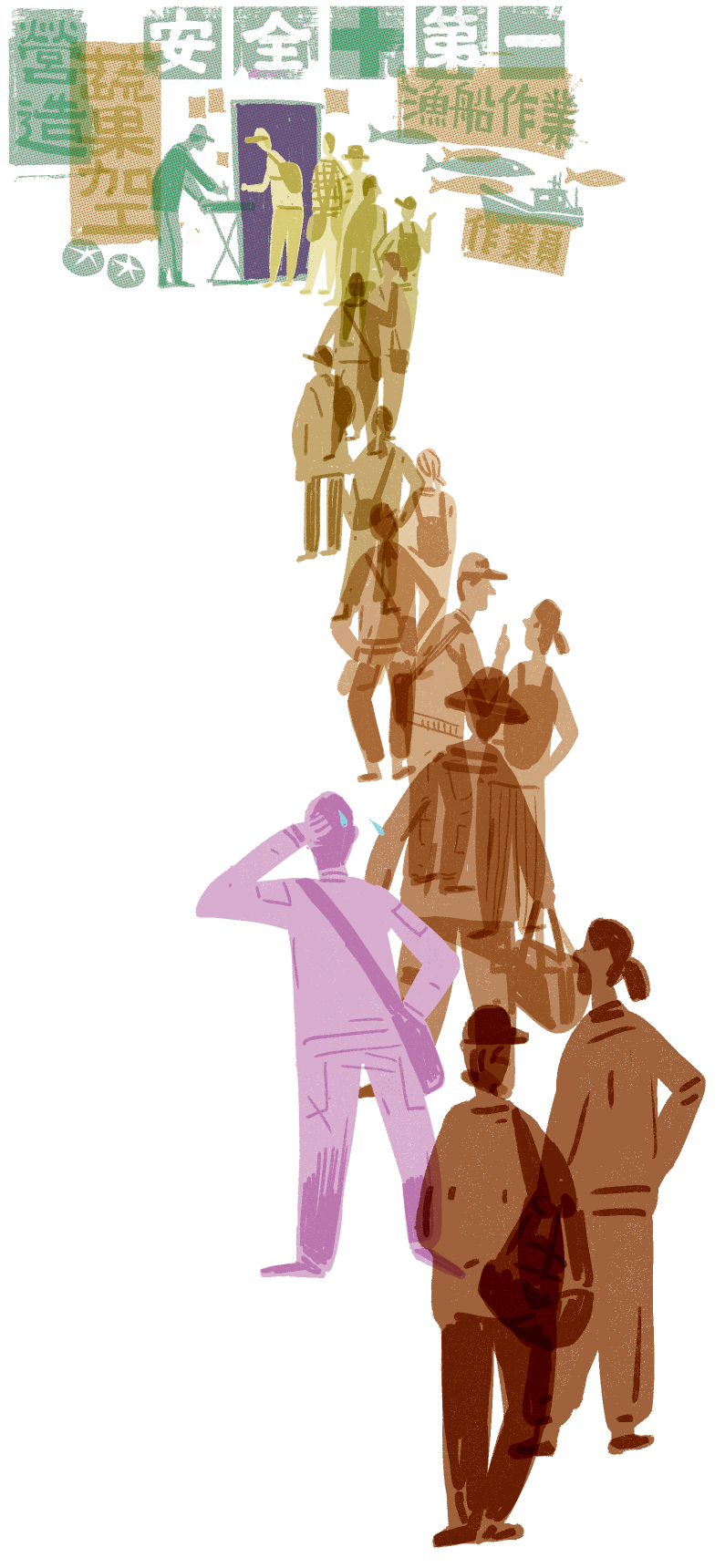
My parents sent me wandering
I wept as I walked
Where to? To Taipei
My loved one is not there
It hurts so bad inside,
can't find my loved one.
──Wandering to Taipei
Wandering to Taipei is an original song that was popular among the forest compartments in indigenous areas, author unknown. The lyrics describe how indigenous peoples felt when they left home to work in the city. The song spread from forest compartments to indigenous communities, then from indigenous communities to the city, and finally from Taipei back to indigenous communities.
Indigenous Peoples Wandering to the City
Amidst Economic Takeoff in 1960s
Indigenous peoples used to joke that “we always take on the highest, deepest and farthest job!” You see indigenous peoples working as carriers on the highest mountains, miners in the deepest ground below, and fishermen out on the farthest ocean.
The start of indigenous migration towards the city is closely connected to the overall economic development in Taiwan. Back then, Taiwan was just transforming from an agricultural to an industrial society, with manpower concentrated in factories. A majority of indigenous peoples relocated from their indigenous communities to the metropolitan area, looking to find work and improve their lives, thus leading a collective career shift of the indigenous peoples.
After WWII in the 1960s, Taiwan experienced economic restructuring and the secondary industry soon replaced the primary as main development to pursue. Furthermore, the various government development projects including gurban constructions and significant transport constructions all require major labor input, pulling the indigenous population towards the metropolitan area. Washed by the wave of capitalism, everyday life essentials must be calculated in and obtained via monetary means, the traditional self-sufficient way of life in indigenous communities was seriously challenged. Food, daily commodities, medical service, transportation, education, even basic utilities, everything required money, income in the agricultural society is limited, thus further pushing the indigenous population towards cities.
However, living away from home is not easy. Even though income may be higher in the cities, expenses were also higher. In the meantime, indigenous peoples living in cities are unable to acclimatize to life in the cities due to the lack of the support system they formerly had in their indigenous communities. Economic challenges aside, the stereotype and discrimination the mainstream society bears against indigenous peoples also led to various restrictions towards indigenous workers. Indigenous employment difficulties and limitations stem from two aspects: on labor force supply, indigenous workers are comparatively unfavorable in the labor market of contemporary commercial society in terms of education, skills, and social adaptability; on demand for labor force, employers discriminate against indigenous workers and provide poor terms of labor, leading to adverse conditions for indigenous peoples in seek of employment.
Although the unemployment rate for indigenous peoples has decreased significantly over the years according to statistics, in reality, due to the fact that employments are often temporary or that government jobs are project-based, indigenous workers are often faced with constant un employment and instability of being between jobs.
It is difficult for indigenous workers to survive in cities, and the issue of unemployment must be highlighted; providing employment opportunities locally in indigenous communities should be one of the solutions. However, due to the limited resources in indigenous areas, job opportunities including Forest Bureau rangers and national forest park police are rare with restricted qualifications; on top of which, indigenous communities are mostly located in remote areas where business opportunities are few, hence employment within the communities is still awaiting solution.
Meanwhile, the main barrier to the expansion of indigenous economic businesses and industries lies in the lack of funding. Even though there is currently the Indigenous Economic Business Development Fund provided by the government to offer loans, collaterals including land and house put up by indigenous peoples are often low in value, which means loans approved by banks are often nowhere near the required amount, and greatly impacting the will and opportunity of indigenous peoples to invest and start businesses.

On That Same Sinking Boat
with the Migrant Worker Policy in 1980s
Men in construction formwork and women in factories, pretty much the common image of indigenous workers who left their hometown in the 1980s. However, facing the globalization of labor force flow, the government gradually adopted the policy of introducing migrant workers, impacting first and foremost the high labor-intensive and low technology-intensive types of work. To lower cost and increase profit, capitalists are more inclined to hire cheap migrant workers unprotected by the Labor Standards Act than domestic workers, which in turn stagnated the improvement of their working environment and salary package. It caused the direct perception of the indigenous society being deprived of job opportunities, and led to numerous protests in front of the current Ministry of Labor against the impact of such policy towards indigenous workers.

In 1998, organizations on indigenous issues including Taiwan Indigenous Workers Alliance, Taiwan Indigenous Peoples’ Right Advocacy Association, Union of Indigenous Communications, Yu-shan Theological College & Seminary, Taipei Indigenous College Center, NTU Absoundtrack Club, and NCCU Talu'an Club co-initiated the appeal of “we want to work, say no migrant workers”; it was a tandem action protesting the migrant worker policy that lasted three consecutive years, initiated by indigenous organizations.

Concerns regarding migrant workers impacting the indigenous workers' right to work did not end as time went by. It lasted until today. In 2015, Puyuma legislator Chen Ying pointed out that there are currently more than 21,000 escaped migrant workers working in manufacturing and construction, more than 1/3 of the indigenous peoples working in both industries, and if a warning limit is not established for the number of migrant workers introduced, employment opportunities for indigenous peoples will be squeezed.
She requested that administrative departments conduct warning limit investigations in the future, and that investigation must cover the gaps in indigenous factors, population, and categories of work, to protect the rights to work for domestic workers.
 However, according to the Study on the Impacts of Introducing Migrant Workers to the Employment and Labour Rights of Indigenous Peoples in Taiwan, commissioned by the Ministry of Labor and in January 2018, it was pointed out that “the phenomenon of foreigners working illegally in Taiwan... is mainly because the lower the technology-demand is for domestic small or micro business, the higher the manpower-demand, but they are either unable to hire domestic workers at the market wage or because domestic workers refuse this type of work, so they resort to the hiring of illegal foreign workers.”
However, according to the Study on the Impacts of Introducing Migrant Workers to the Employment and Labour Rights of Indigenous Peoples in Taiwan, commissioned by the Ministry of Labor and in January 2018, it was pointed out that “the phenomenon of foreigners working illegally in Taiwan... is mainly because the lower the technology-demand is for domestic small or micro business, the higher the manpower-demand, but they are either unable to hire domestic workers at the market wage or because domestic workers refuse this type of work, so they resort to the hiring of illegal foreign workers.”

On evaluating the situation of the squeezed indigenous labor market, the study showed that “regarding urban indigenous interviewees, they are mostly limited by their education and thus difficult to change career path, if the industry suffers recession or they face employment instability, they will likely blame the employment
dilemma on the crowding-out effect caused by foreigners working in Taiwan. But the reasons indigenous-concentrated industries are impacted by foreign workers are complicated. Indigenous interviewees in the construction industry believe that they are influenced mainly by foreign workers working illegally in the domestic employment market. In terms of manufacturing, they believe that the two have low relevance, complementary perhaps but not much of an influence... As for the serious lack of workers in agriculture in indigenous areas, it shows that there is large demand in the labor market, and if domestic workers are not willing to work in agriculture, the demand will be satisfied through illegal channels, and that is a serious issue the government must tackle.”
From the above study, we can see that introducing migrant workers may have an impact on the employment of indigenous workers, but it is not the main reason behind the dilemma of indigenous employment. On the other hand, from the many reports and articles in recent years, we can see how migrant workers are being exploited and oppressed in the labor environment in Taiwan. Whether it's the not-so-occasional exploitation of commission charged by the agency, the frequent sexual assaults on female migrant domestic workers, or the harsh living conditions of migrant workers in the construction industry, for example, the prison-like tiny dormitory for migrant workers which demonstrates the inequality and unfriendliness in the labor market towards migrant workers. In 2017, the news of police firing 9 shots within 12 seconds killing the escaped migrant worker Nguyen Quoc Phi shocked the society. How is an escaped migrant worker a wanted felony? Is Taiwan society looking at migrant workers through lenses colored with discrimination the same way they looked at indigenous workers 30 years ago, thus leading to the numerous oppression and tragedies?
While we are desperate to comb through the reasons and flipping the dilemma of indigenous workers wandering to the city, can we also sympathize with the migrant workers relocating to Taiwan from their home country, facing extremely pressurizing environment and conditions at work, and provide the same support rather than opposing the also oppressed. This is an issue we must contemplate on while facing the issue of indigenous workers.
Any New Possibilities
for Contemporary Indigenous Workers?
According to 2019 Q1 Employment Status Survey of Indigenous Peoples by the Council of Indigenous Peoples, manufacturing (14.58%) and construction (13.51%) industries have the highest percentage of indigenous workers, followed by accommodation and food service (10.39%), while the labor force participation rate in other industries are all less than 10%. Comprehensively speaking, the unemployment rate gap between indigenous peoples and the general population is gradually closing per year, compared to previous years, indigenous employment has significantly improved in quantity; however, in terms of the “quality” of employment, indigenous workers still have a higher percentage working in high labor-intensive jobs than the general population, mainly in manufacturing and construction. Although technical work doesn't necessarily mean low salary, it is comparatively more easily influenced by the economic environment and policies such as industry relocation, introduction of migrant workers, minimum wage increase, and one fixed day off and one flexible rest day, policies that could have major impact on the labor market will first hit the high labor-intensive industries before anything else.

In 2001, Indigenous Peoples Employment Rights Protection Act was enacted in Taiwan, aiming to increase the labor participation and economic status of indigenous workers through means including guaranteed employment quota in the public sector, assistance provided by indigenous people's cooperatives, public construction and government procurement guarantee, and other methods of empowerment to facilitate employment. However, such guarantee is still limited to contract employees, security guards, mechanics, drivers, maintenance workers, janitors, fee collectors, and other non-technical jobs that do not require the employment qualifications of civil servants. It does not facilitate indigenous labor participation in other industries, nor does it fully guarantee the right to work.
 Meanwhile, the academia is also attempting to change the status quo through education reform. The indigenous student preferential treatment initiated in the early years due to the policy of assimilation is transformed into “affirmative action for group development”. In addition to the general policy of score adjustment based on indigenous language proficiency examination, aiming to encourage the exposure of indigenous students to their native cultures, key talents in indigenous affairs are cultivated through the establishment of programs for indigenous peoples, including law program and land policy program, so that in the future, when indigenous students join the workforce, they will be equipped with more professional skills and more employment choices while empowering them for the future of indigenous self-governance.
Meanwhile, the academia is also attempting to change the status quo through education reform. The indigenous student preferential treatment initiated in the early years due to the policy of assimilation is transformed into “affirmative action for group development”. In addition to the general policy of score adjustment based on indigenous language proficiency examination, aiming to encourage the exposure of indigenous students to their native cultures, key talents in indigenous affairs are cultivated through the establishment of programs for indigenous peoples, including law program and land policy program, so that in the future, when indigenous students join the workforce, they will be equipped with more professional skills and more employment choices while empowering them for the future of indigenous self-governance.

All policies, large or small, Whether it's direct vocational training or flipping the status quo through the fundamental educational empowerment, it may all take a long time before results can be verified. Meanwhile, how to establish a friendlier society and workplace in the mainstream society is something we must also tackle.




